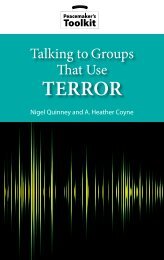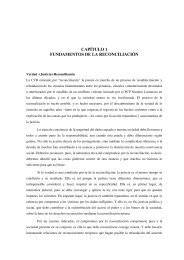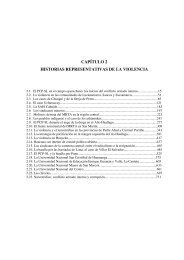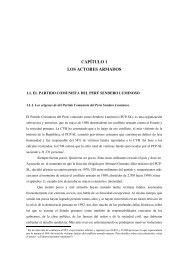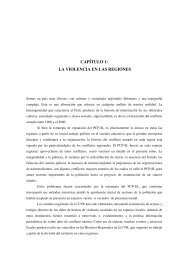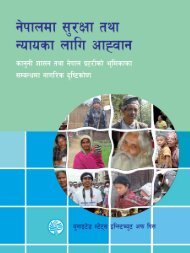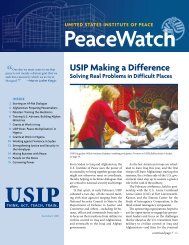Download PDF (5.43 MB) - ReliefWeb
Download PDF (5.43 MB) - ReliefWeb
Download PDF (5.43 MB) - ReliefWeb
Create successful ePaper yourself
Turn your PDF publications into a flip-book with our unique Google optimized e-Paper software.
peacebuilding toolkit for educators | middle school edition45 minutesPart 1ProceduresExtension Activity 1Have students turn their commercial into aprint advertisement or poster.Extension Activity 2Have students research an individual whoworks for an organization dedicated topeacebuilding. What is his/her job description?What is his/her academic and professionalbackground? Interview this personby phone or email to learn more aboutwhat they do and why they chose to do it.I. Essential Questions:1. How do organizations work as peacebuilders?2. Why are organizations important in helping individuals promote peace?II. Motivation (5 minutes)1. Tell students that they are going to look beyond individual peacebuildersand focus on organizations that work for peacebuilding. Ask:◆◆ What organizations do you know of that build peace?2. Write student responses on the board. If they have difficulty generatinga list, you can use some of the organizations from the list of Nobel PeacePrize winners. An article listing winners (both people and organizations)appears at this link: http://nobelprize.org/nobel_prizes/peace/articles/lundestad-review/. Also, the United States Institute of Peace has a comprehensivelist of international organizations at this link: http://www.usip.org/publications/international-organizations.3. Ask students what kind of organizations they have identified: local,national, international, governmental, nonprofit? What are some of thedifferences between these kinds of organizations? Note that governments,themselves, can work for peace. The U.S. is often a third party engagedin building peace. Parties in conflict often look to trusted outside governmentsto help end conflicts in their region.III. Teacher Directed (10 minutes)1. Tell students that when groups work together to prevent or manageconflicts, they can sometimes reach wider audiences and get more peopleengaged because they have the structures in place to do so.2. Share that in groups of three, students will research a national or aninternational organization that works for international peace, e.g. USIP,U.N., or Peace Links, an international women’s peace education groupfounded in 1981, which was a major force in ending the Nuclear Arms race,and write a commercial about that organization which they will perform infront of the class. If you have a video camera, you may choose to film theperformances.3. Distribute the Note-Taking Form for Researching a Peacebuilding OrganizationWorksheet and the Creating a Commercial Handout. Review both withstudents.4. Divide students into groups of three. Assign each student an internationalorganization that works for peace or allow them to select their own froma list you have generated, from the list they generated at the beginningof class, or from their own research. If students do not have access to theInternet in class for researching their organization, prior to class you willneed to determine the organizations to be researched and print informationfrom each organization’s website for students to review. Again, theUnited States Institute of Peace has a comprehensive list of internationalorganizations at the following link: http://www.usip.org/publications/international-organizations and the Nobel Prize website has informationabout organizations that have won the peace prize.106 Peacebuilding Toolkit for Educators



